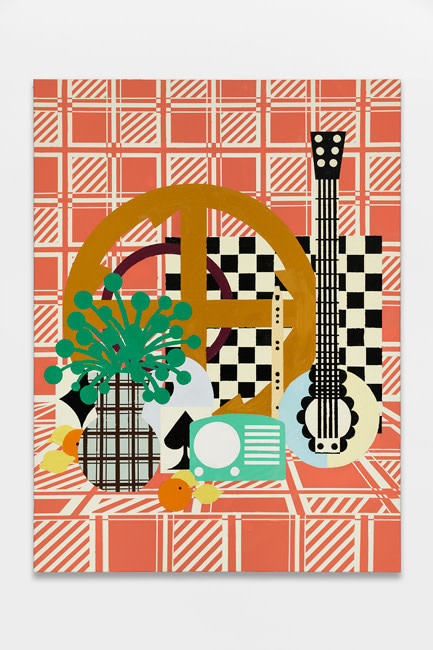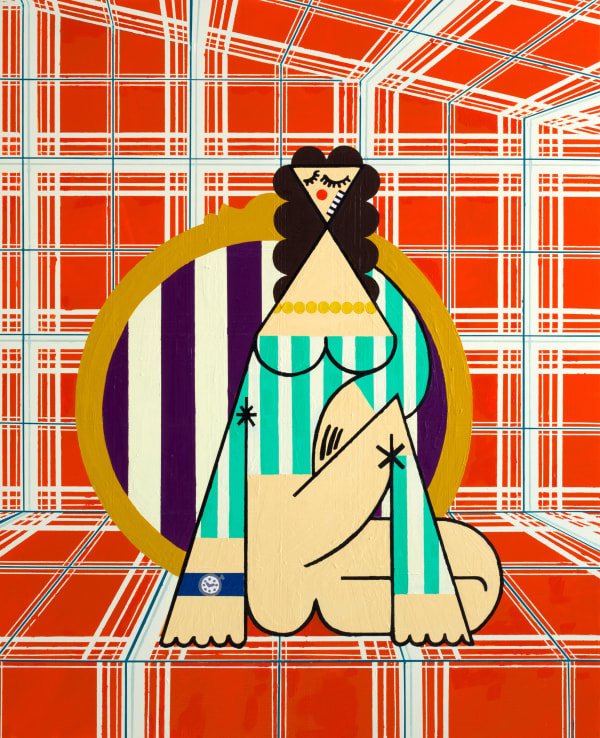Farah Atassi: New Paintings
The references and allusions in my paintings are not hints for the educated observer: they are formal propositions that need to be understood in their claim to universality.
François Ghebaly is proud to present New Paintings, Farah Atassi’s second solo exhibition, originally scheduled to open at the gallery and now inaugurating our first online viewing room on April 24, 2020.
The French-Syrian artist Farah Atassi uses the language of Cubism and the legacy of modernist masters to render views of everyday life. Through a meticulous collage of sourced imagery, graphic patterns and fragments of art history, she creates thick paintings incorporating a dense layering of oil and glycerol geometric forms. In these, she tackles some of the main subject matters in classical painting such as portraiture, still life, the bathers or the studio. Channeling references from Sonia Delaunay, Jean Brusselmans and the aesthetics of the 1980’s Memphis design movement, Atassi organizes them in carefully composed vitrines. As the artist describes it, “I make figurative painting with an abstract vocabulary.”
To create her paintings, the artist constructs a masking tape grid outlining the structure of architectural backgrounds, establishing a vanishing point and a horizon line from which her spaces unfold. These set the stage for complex figures and domestic objects occupying the center of the canvas. Boldly colored geometric characters—always women—take the stage either sitting, lounging or playing, permanently performing in intricate environments. In Seated Woman and Model in Studio 5, female characters recline among a set of abstract paintings. While, in The Sunset and The Game 2 Atassi explores movement with playful bathers nimbly throwing a ball, defying the static gravity of their bodies. The latter incorporates an organic jagged pattern, increasing the impression of movement while evoking Matisse’s cut-outs.
Farah Atassi’s still life works introduce anachronistic objects varying from music instruments, flower vases, citrus fruits and mid-century radio. These representations are artificially set in time, while the clock—a recurrent motif in her paintings—regularly marks the cadence. In Studio With Red Banjo the objects blend with their surrounding anthropomorphic shapes divulging faces and figures which animate the scene such as the guitar, an unequivocal token of the female body. Meanwhile, in Still Life in Pink and Still Life with Eggs, the objects are theatrically motionless.
The disruption of perspectives between the flat surface of Atassi’s main characters and the depth of their background lies at the heart of her practice. Her structured presentation is as important as the subject depicted, classifying a formidable inventory of influences, bodies and objects. This rigorous protocol is a catalyst for chance and expression, working against the dominant forms of our age.
Farah Atassi (b. 1981 in Brussels) has exhibited widely internationally, with recent solo exhibitions that include the Consortium of Dijon; the Fine Arts Museum of Cambrai; the Museum Permeke, Jabbeke and the Extra City Kunsthal, Antwerp. Her works are held in numerous public and institutional collections including the Musée National d’Art Moderne, Centre Georges Pompidou, Paris; the Musée d’Art Moderne de la Ville de Paris, Paris; the Marciano Art Foundation Collection, Los Angeles; the Fondation Louis Vuitton pour la Creation among others. She lives and works in Paris.
-
 Farah Atassi, Studio With Red Banjo, 2020
Farah Atassi, Studio With Red Banjo, 2020 -
 Farah Atassi, Model in Studio 5, 2020
Farah Atassi, Model in Studio 5, 2020 -
 Farah Atassi, The Sunset, 2020
Farah Atassi, The Sunset, 2020 -
 Farah Atassi, Woman in Profile, 2020
Farah Atassi, Woman in Profile, 2020 -
 Farah Atassi, Still Life With Eggs, 2020
Farah Atassi, Still Life With Eggs, 2020 -
 Farah Atassi, The Show, 2020
Farah Atassi, The Show, 2020 -
 Farah Atassi, Still Life in Pink, 2019
Farah Atassi, Still Life in Pink, 2019 -
 Farah Atassi, Seated Woman, 2020
Farah Atassi, Seated Woman, 2020 -
 Farah Atassi, The Game 2, 2019
Farah Atassi, The Game 2, 2019











